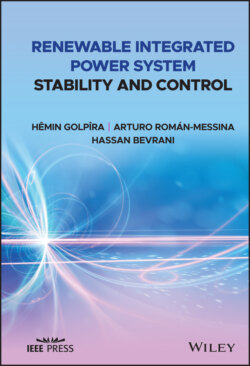Читать книгу Renewable Integrated Power System Stability and Control - Hassan Bevrani - Страница 23
1.4.1 Modeling of Frequency, Voltage, and Angle Controls
ОглавлениеThe participant bulk SGs with different participation factors are the main actuators for the frequency control system. Following a disturbance, the variation of frequency and tie‐line power is applied to the LFC system via the ACE signal. Then, depending on the accessible amount of regulation power, the LFC system will be activated to compensate the power grid frequency and return it to the nominal value. The LFC system can attenuate the frequency and active power changes from tenth of seconds to few minutes. Therefore, the ACE signal may provide the output of system model for frequency control. Considering the frequency response dynamics [32], the candidate scheduling parameters are system inertia, aggregated generating time constant, droop and damping coefficient. The measurement‐based dynamics identification and system modeling will be for adaptive control and online parameters tuning of the LFC system. The increasing size and diversification of demand/power sources magnify the importance of this issue in the modern power grids.
Unlike grid frequency, since the voltage is known as a local variable, a higher number of measured points are required. For proposing the data‐driven models, several concepts like Thevenin equivalent system and oscillation model will be applied and the results will be used for the grid voltage analysis, and then optimal tuning of AVRs. The measurements of voltage, current, and phase deviations of existing nodes are considered as the most important inputs of model. The system output can be the terminal voltage change of the SGs. In order to construct an appropriate LPV model for voltage control, relevant scheduling parameters must be selected. There are several choices for the scheduling parameters (low‐frequency resonance mode, reactive power of the system, Thevenin equivalent impedance/admittance, etc.) that must be compared and discussed using effective analytical and simulation‐based studies. In choosing efficient scheduling parameters, a tradeoff between accuracy and simplicity of the resulting LPV model is needed. The measurements are also used to perform some important graphical tools and curves to evaluate the stress conditions and to analyze the voltage stability criteria. For instance, the data are fitted to the active power–voltage curve (PV curve) of the equivalent system by suitable fitting approaches such as least squares method.
The SGs equipped with a PSS and RESs participating in power oscillation damping are considered as the main actuators of the control system. It is assumed that some of the RESs are not operating at their maximum generated power, so that they can help for power oscillation damping by reducing/increasing a small percentage of their power generation. The system to be controlled is a multivariable system, where the inputs are the reference voltages for the AVR of the SGs as well as the auxiliary signals that will be added to the reference active and reactive powers of RESs. The system outputs can be the active power or the speed (or both, depending on the type of PSSs) of the SGs and the measured active and reactive powers of the RESs. In order to construct an appropriate model for power oscillation damping, we need to choose the scheduling parameters.
